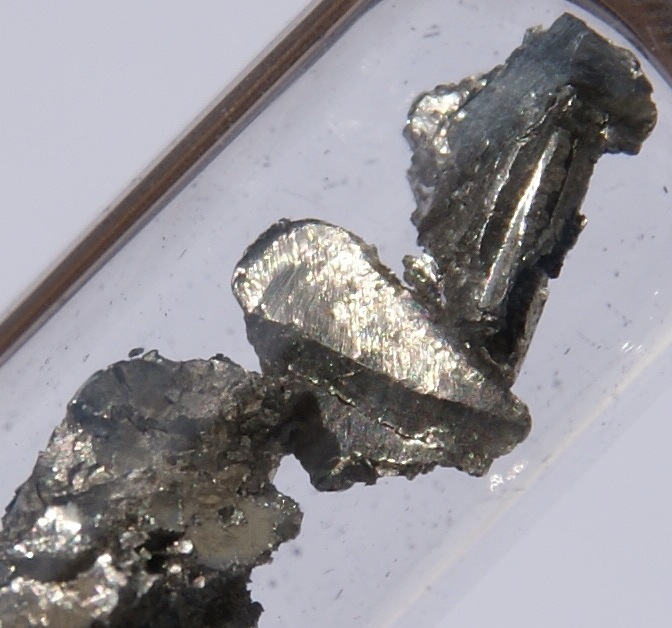Praseodymium

Praseodymium
(Image source - images-of-elements.com - lic.
under CC BY 1.0)
Praseodymium - overview
Praseodymium is a soft, silvery metal. Its name derives from the Greek - "prasios didymos", which means "green twin". Praseodymium is element number 59 in the periodic table of elements and is one of the lanthanide (aka "lanthanoid") series of elements. [1]
When pure praseodymium metal is exposed to air it reacts, becoming coated with its oxide, which is green - and this slowly "spalls" (i.e. flakes) off, leaving more metal exposed which then oxidises. Over time praseodymium will thus corrode completely, and so samples of the pure metal are either stored under oil, coated with plastic or sealed into glass in an atmosphere of argon. [1] [2]
Praseodymium was first isolated by Baron Carl Auer von Welsbach in 1885 from didymium, but was not obtained in relatively pure form until 1935. [3] Didymium, once thought to be one element, was in fact composed of not only praseodymium but also neodymium, the next element in the periodic table at no. 60. Praseodymium in elemental form is obtained by passing electricity through praseodymium fluoride.
Praseodymium Resources and Production
Praseodymium, which has no known biological role, is a somewhat uncommon element, making up just 9.5 ppm of the earth's crust. It is one of the more common of the 'rare earth elements'. For comparison, copper makes 50 ppm, tin 2.2 ppm and gold 0.0011 ppm. Praseodymium is difficult to isolate and available in lesser quantity than neodymium, but is in less demand. Praseodymium price is similar to that of neodymium (around $240 / kg - April 2011) but both have seen substantial price increases in the past 12 months. [4]
Praseodymium occurs in the minerals monazite and bastnasite, and is extracted through the same multi-stage process as other rare earth elements (see gadolinium for a full description of this).
Naturally-occurring praseodymium consists of only one stable isotope, 141 Pr.
Praseodymium Uses
Praseodymium has a number of uses though less so than many of the other rare earth elements. As some of its qualities are very similar to those of other rare earth elements, its use is hence sometimes dictated by the availability and price of the others: Praseodymium is paramagnetic and is sometimes used in permanent magnets for motors instead of neodymium, which is in high demand.
Praseodymium is one of the components of misch metal, which is combined with iron and magnesium oxides to make the flints used in cigarette lighters. Misch metal is pyrophoric, which means that it gives out sparks when scratched. Misch metal contains about 4%-5% praseodymium.
Praseodymium is added to magnesium alloys which are used for high-strength parts for aircraft engines. [1]
Praseodymium and neodymium are used in "didymium glass", which is used for the lenses of goggles for glass blowers. Praseodymium and neodymium have ideal spectral absorption characteristics to absorb the orange color of the sodium flame, allowing glass blowers to see the work more clearly. Praseodymium salts, like those of other lanthanide elements, are also used as coloring agents in glass, enamels and ceramics industries. Praseodymium gives a good yellow color. [6]
Praseodymium is used in the cores of carbon arc lights used in movie studio lighting and video projectors. The carbon arc lamp's light, normally brilliant white, can be colored yellow by the addition of praseodymium. [6] [7]
Praseodymium oxide has catalytic properties. It has been used with cerium oxide as an oxidation catalyst [1] and recently, nanostructured praseodymium oxide has been found to have greater catalytic activity than 'ordinary' praseodymium oxide. [8]
Around 2,500 tons of praseodymium (III) oxide are produced per year (2003). It can be used in combination with silicon as a dielectric material. [9] It is also sometimes used in photographic filters and ceramic tiles. [10]
Praseodymium is also used in some mirrors and lenses including airport signalling lenses. [11]
Praseodymium Facts
| Name | Praseodymium |
| Symbol | Pr |
| Atomic Number | 59 |
| Melting point (Celsius) | 935ºC |
| Density | 6.64 g/cc |
| Hardness (Brinell) | 481 MPa |
| Resistivity (nanoOhms / meter at 20ºCelsius) | 700 |
Praseodymium - References:
[1] http://en.wikipedia.org/wiki/Praseodymium
[2] http://images-of-elements.com/praseodymium.php
[3] http://www.webelements.com/praseodymium/
[4] http://www.metal-pages.com/metalprices/praseodymium/
[5] http://www.rsc.org/chemistryworld/podcast/Interactive_Periodic_Table_Transcripts/Praseodymium.asp
[6] http://education.jlab.org/itselemental/ele059.html
[7] http://www.chemistryexplained.com/elements/P-T/Praseodymium.html
[8] http://pubs.acs.org/doi/abs/10.1021/jp0768524
[9] http://en.wikipedia.org/wiki/Praseodymium(III)_oxide
[10] http://wiki.chemeddl.org/index.php/PTL:Praseodymium
[11] http://www.molycorp.com/praseodymium.asp

This website is not investment advice or a recommendation to buy or sell.


